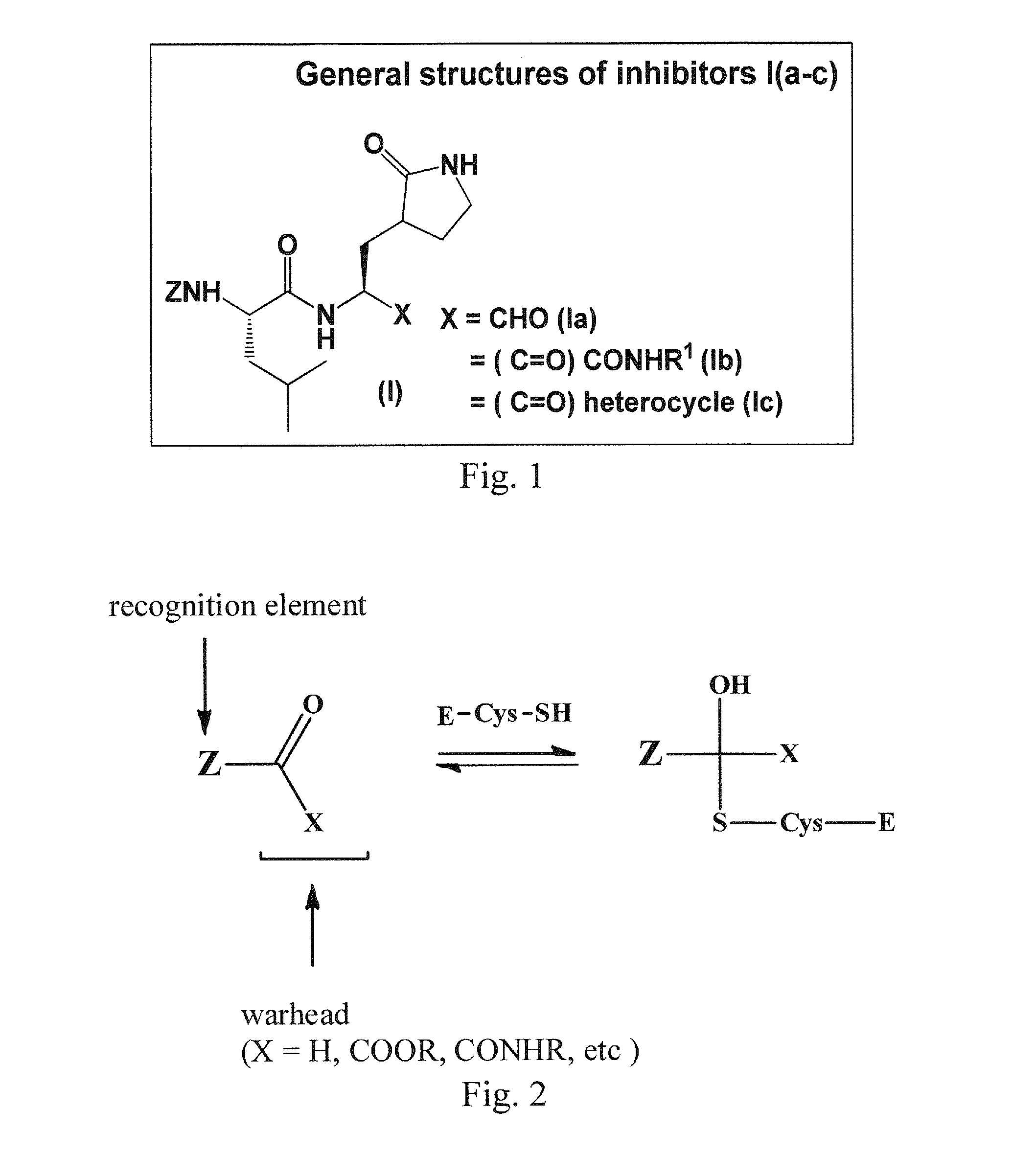Macrocyclic and peptidomimetic compounds as broad-spectrum antivirals against 3c or 3c-like proteases of picornaviruses, caliciviruses and coronaviruses
a broad-spectrum, antiviral technology, applied in the direction of peptides, group 5/15 element organic compounds, drug compositions, etc., can solve the problems of outbreaks in enclosed settings, rare broad-spectrum antivirals, and short specificity range, so as to prevent or inhibit the replication of viruses in cells
- Summary
- Abstract
- Description
- Claims
- Application Information
AI Technical Summary
Benefits of technology
Problems solved by technology
Method used
Image
Examples
example 1
Background of 3C and 3CL Protease Inhibitors of Norovirus and Other Viruses in the Picornavirus-Like Supercluster
[0061]Noroviruses are a leading cause of food-borne and water-borne non-bacterial acute gastroenteritis. Norovirus infections constitute an important health problem with an estimated 23 million cases of gastroenteritis occurring annually in the U.S., causing 50,000 hospitalizations and 300 deaths. There are currently no effective vaccines or antiviral therapeutics for the treatment of norovirus infection.
[0062]Noroviruses are small non-enveloped viruses of the Caliciviridae family. The genome of Norwalk virus (NV), a prototype of noroviruses, consists of a single-stranded, positive sense RNA molecule of ˜7.7 Kilo bases that consists of three open reading frames (ORFs) that encode a 200 kDa polyprotein (ORF1), a major capsid protein VP1 (ORF2), and a small basic protein VP2 (ORF3), respectively. The polyprotein is co- and post-translationally processed by a virus-encoded p...
example 2
Synthesis of Macrocyclic Inhibitors
[0072]
[0073]Based on the aforementioned considerations, a macrocyclic inhibitor was assembled in a convergent fashion by first constructing fragments 4 and 9, followed by subsequent coupling of the two fragments to generate acyclic precursor 10 (FIG. 5). Cyclization was subsequently accomplished using click chemistry.
Materials and Methods
[0074]The 1H NMR spectra were recorded on a Varian XL-300 or XL-400 NMR spectrometer. Melting points were determined on a Mel-Temp apparatus and are uncorrected. Reagents and solvents were purchased from various chemical suppliers (Aldrich, Acros Organics, TCI America, and Bachem). Silica gel (230-450 mech) used for flash chromatography was purchased from Sorbent Technologies (Atlanta, Ga.). Thin layer chromatography was performed using Analtech silica gel. The TLC plates for all the compounds were eluted using two different solvent systems and visualized using iodine and or UV light. Each individual compound was i...
example 3
Evaluation of Inhibitors of 3C and 3CL Proteases of Viruses in the Supercluster
[0089]The inhibitory activity of aldehyde 13 (FIG. 6) was evaluated in vitro. The codon-optimized cDNAs for 3C protease or 3CL protease of NV, SARS-CoV, and EV71 were synthesized fused with 6 His at the N-terminal (Genscript, Piscataway, N.J.). Each synthesized gene or amplified product was then subcloned into the pET-28a(+) vector. 3C protease and 3CL protease were then expressed and purified using standard methods before being evaluated using fluorescence resonance energy transfer (FRET) protease assays.
[0090]The designation of substrate residues for P1 and P1′ started at the scissile bond and counting towards the N- or C-termini, respectively. The FRET protease assay was performed as follows. Stock solutions (10 mM) of the substrates and the compounds were prepared in dimethyl sulfoxide (DMSO) and diluted in assay buffer. The assay buffer comprised 20 mM HEPES buffer containing NaCl, EDTA, Glycerol, an...
PUM
| Property | Measurement | Unit |
|---|---|---|
| body weight | aaaaa | aaaaa |
| temperature | aaaaa | aaaaa |
| temperature | aaaaa | aaaaa |
Abstract
Description
Claims
Application Information
 Login to View More
Login to View More - R&D
- Intellectual Property
- Life Sciences
- Materials
- Tech Scout
- Unparalleled Data Quality
- Higher Quality Content
- 60% Fewer Hallucinations
Browse by: Latest US Patents, China's latest patents, Technical Efficacy Thesaurus, Application Domain, Technology Topic, Popular Technical Reports.
© 2025 PatSnap. All rights reserved.Legal|Privacy policy|Modern Slavery Act Transparency Statement|Sitemap|About US| Contact US: help@patsnap.com



